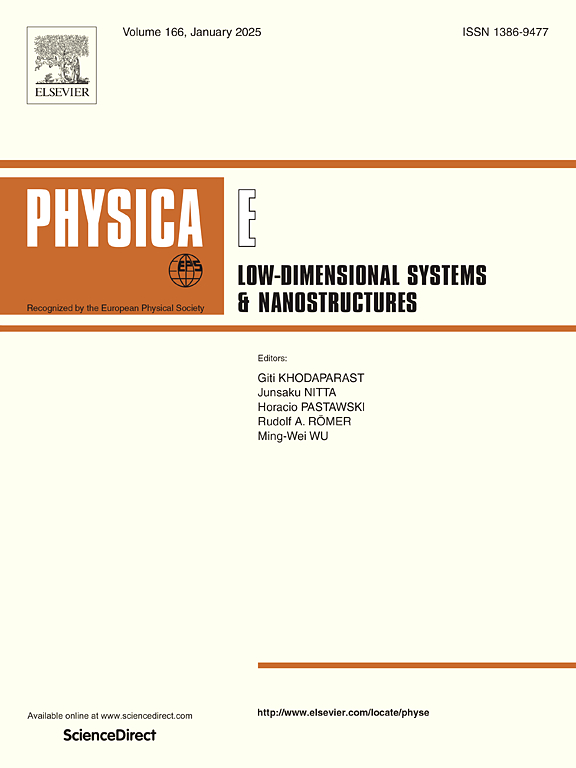Double-layer silicene nanoribbons controlled by carbon atoms: doping, adsorption, embedding
IF 2.9
3区 物理与天体物理
Q3 NANOSCIENCE & NANOTECHNOLOGY
Physica E-low-dimensional Systems & Nanostructures
Pub Date : 2025-06-11
DOI:10.1016/j.physe.2025.116313
引用次数: 0
Abstract
In recent years, due to their compatibility with the mature silicon-based semiconductor industry, new silicene materials have attracted much attention due to their rational design and synthesis. This paper uses the SCC-DFTB method to study the effects of doping, adsorption and embedding carbon atoms on the electronic properties of double-layer silicene nanoribbons (SiNRs). The addition of carbon atoms causes significant changes in the geometric structure and energy band structure of SiNRs.Among them, under the three control methods, the structural stability and electronic properties of SiNRs are closely related to the concentration and position of carbon atoms. The band gap (Eg) increases or decreases regularly, and the electronic properties change from semiconductor to metal. The charge transfer trend after controlling three C atoms is also very different. The carbon atoms gain electrons (charge> 4.0), and the surrounding Si atoms lose electrons. These changes are due to the redistribution of charge. The p-orbital of silicon makes the main contribution, and the p-orbital of carbon makes a weak contribution. The concentration of carbon atoms can regulate the degree of hybridization. Introducing carbon atoms can be an accurate tool to effectively regulate the electronic properties of SiNRs, which can be used to customize the electronic properties of SiNRs and promote their application in the next generation of nanoelectronics and optoelectronic devices.
碳原子控制的双层硅纳米带:掺杂、吸附、包埋
近年来,新型硅烯材料由于与成熟的硅基半导体工业相兼容,其合理的设计和合成备受关注。本文采用SCC-DFTB方法研究掺杂、吸附和包埋碳原子对双层硅纳米带(SiNRs)电子性能的影响。碳原子的加入使sinr的几何结构和能带结构发生了显著的变化。其中,在三种控制方法下,SiNRs的结构稳定性和电子性能与碳原子的浓度和位置密切相关。带隙(Eg)有规律地增加或减少,电子性质从半导体转变为金属。控制三个C原子后的电荷转移趋势也大不相同。碳原子获得电子(电荷);4.0),而周围的Si原子失去电子。这些变化是由于电荷的再分配。硅的p轨道起主要作用,碳的p轨道起微弱作用。碳原子的浓度可以调节杂化程度。引入碳原子是有效调控sinr电子性能的精确工具,可用于定制sinr的电子性能,促进其在下一代纳米电子和光电子器件中的应用。
本文章由计算机程序翻译,如有差异,请以英文原文为准。
求助全文
约1分钟内获得全文
求助全文
来源期刊
CiteScore
7.30
自引率
6.10%
发文量
356
审稿时长
65 days
期刊介绍:
Physica E: Low-dimensional systems and nanostructures contains papers and invited review articles on the fundamental and applied aspects of physics in low-dimensional electron systems, in semiconductor heterostructures, oxide interfaces, quantum wells and superlattices, quantum wires and dots, novel quantum states of matter such as topological insulators, and Weyl semimetals.
Both theoretical and experimental contributions are invited. Topics suitable for publication in this journal include spin related phenomena, optical and transport properties, many-body effects, integer and fractional quantum Hall effects, quantum spin Hall effect, single electron effects and devices, Majorana fermions, and other novel phenomena.
Keywords:
• topological insulators/superconductors, majorana fermions, Wyel semimetals;
• quantum and neuromorphic computing/quantum information physics and devices based on low dimensional systems;
• layered superconductivity, low dimensional systems with superconducting proximity effect;
• 2D materials such as transition metal dichalcogenides;
• oxide heterostructures including ZnO, SrTiO3 etc;
• carbon nanostructures (graphene, carbon nanotubes, diamond NV center, etc.)
• quantum wells and superlattices;
• quantum Hall effect, quantum spin Hall effect, quantum anomalous Hall effect;
• optical- and phonons-related phenomena;
• magnetic-semiconductor structures;
• charge/spin-, magnon-, skyrmion-, Cooper pair- and majorana fermion- transport and tunneling;
• ultra-fast nonlinear optical phenomena;
• novel devices and applications (such as high performance sensor, solar cell, etc);
• novel growth and fabrication techniques for nanostructures

 求助内容:
求助内容: 应助结果提醒方式:
应助结果提醒方式:


